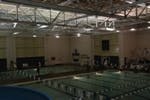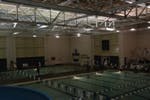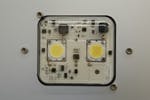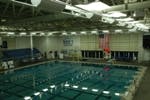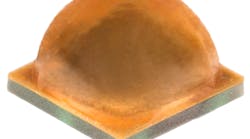Finally, an elaborate truss system held the existing 66 lighting fixtures and tearing it out was cost-prohibitive. “If we had to replace all those fixtures it would not have been cost effective,” said Everett.
After weighing several options, including blanket replacement of the metal-halide luminaires and several different LED vendors, the YMCA decided to work with a provider of task-specific LED lighting, SimplyLEDs (Garden City, ID), and LED array provider Bridgelux (San Jose, CA). Together, they provided a drop-in replacement for each of the 66 fixtures, keeping the still functional and attractive truss system intact.
LED replacement modules
The replacement kit for each fixture consists of 4 Piazza Series LED modules and two power supplies, which consume 150W (see photo). This kit compares to two 400W metal-halide bulbs with ballasts, which consumed approximately 920W each. Energy savings is 770W per fixture or 80 percent.
The design team chose aluminum reflectors to direct the LED light to the pool level. They experimented with various reflector shapes, finally settling on a gull-wing type design for optimal lighting effect.
The light output per fixture is now approximately 13,500 lm at 150W or 90 lm/W efficacy. Although the total lumen output is lower than with the metal-halide bulbs, SimplyLEDs was able to increase light output levels on the pool by 50 percent by taking advantage of the beam angle of the LEDs and the custom-designed reflector (see photo). A CCT of 5000K, very close to that of daylight (5500K), was chosen.
Beyond the savings in energy cost of approximately $20,000/yr, the removal of the metal-halide lamps also eliminated the fire hazard associated with these lights. In addition, whenever there was a power outage, the YMCA had to wait approximately 30 minutes until the metal-halide lamps cooled and could be restarted. This inconvenience no longer exists. Moreover, because the maintenance cost of the LEDs is nearly zero, Everett estimated a maintenance savings of $5000 per year.
Everett said the strong drivers for adopting LEDs were really the terrific energy savings, fast installation and reasonable ROI. “Also, we don’t have much tolerance for interruptions, since we’re open twenty hours a day, seven days a week. The willingness to work after hours and work quickly made a big difference on this project. We needed people who understood our business model and could work within our constraints,” he said.
